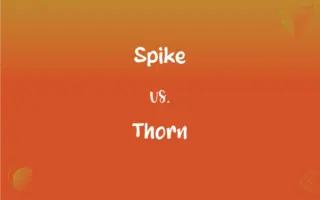Chromogen vs. Chromophore: What's the Difference?
By Harlon Moss & Aimie Carlson || Updated on May 22, 2024
A chromogen is a substance that can develop into a dye or pigment, while a chromophore is a part of a molecule responsible for its color.

Key Differences
A chromogen is a precursor to a pigment or dye, often colorless or slightly colored, that can be converted into a chromophore. Chromogens become colored when they undergo a chemical reaction, typically through oxidation or reduction, enabling them to bind to substrates and produce a visible color. A chromophore, in contrast, is the specific part of a molecule responsible for its color. Chromophores contain conjugated double bonds or aromatic rings that absorb visible light, leading to electronic transitions that result in the appearance of color.
Chromogens and chromophores are interconnected in that chromogens can become chromophores through chemical reactions. However, while chromogens are the precursors capable of forming pigments, chromophores are the actual functional groups within molecules that produce color.
Chromogens are utilized in diagnostic tests, where they react with specific substances to reveal the presence of a target compound through a color change. Chromophores, on the other hand, are intrinsic parts of molecules like hemoglobin and chlorophyll, contributing to the color and function of these biological entities.
Comparison Chart
Definition
Precursor to a pigment or dye
Part of a molecule responsible for color
Function
Converts to a chromophore through chemical reactions
Absorbs light to produce visible color
ADVERTISEMENT
Structure
Often colorless or slightly colored compounds
Contains conjugated double bonds or aromatic rings
Application
Used in diagnostic tests, staining techniques
Found in biological molecules, dyes, and pigments
Role in Color Production
Becomes colored upon chemical reaction
Directly responsible for the molecule's color
Chromogen and Chromophore Definitions
Chromogen
A colorless or slightly colored compound that becomes colored after a chemical reaction.
The histological stain uses a chromogen that reacts with tissue samples to highlight structures.
Chromophore
A part of a molecule responsible for its color.
The chromophore in the dye absorbs light at 450 nm, giving it a blue color.
ADVERTISEMENT
Chromogen
A reagent that forms a colored product when oxidized or reduced.
In microbiology, chromogens help visualize bacterial colonies by producing distinct colors.
Chromophore
A structural feature that determines the color of a compound.
The presence of a conjugated system in the chromophore causes the pigment to appear red.
Chromogen
A substance that can develop into a pigment or dye.
The chromogen in the test turned blue upon reacting with the target enzyme.
Chromophore
A group of atoms within a molecule that absorb visible light.
The chromophore in chlorophyll is essential for photosynthesis by capturing light energy.
Chromogen
A precursor in the synthesis of dyes.
This chromogen is essential in producing vibrant textile dyes.
Chromophore
An entity within a molecule that undergoes electronic transitions to produce color.
The chromophore in hemoglobin changes color when oxygen binds to it.
Chromogen
A compound used in diagnostic assays to indicate the presence of specific substances.
The chromogen in the assay turned pink, indicating a positive result.
Chromophore
A functional group responsible for the optical properties of dyes and pigments.
Altering the chromophore can change the wavelength of light absorbed and the color perceived.
Chromogen
(Chemistry) A substance capable of conversion into a pigment or dye.
Chromophore
Any of various chemical groups that absorb light of certain wavelengths and when present in an organic compound, such as a dye or pigment, are responsible for the color of the compound.
Chromogen
(Biology) A strongly pigmented or pigment-generating organelle, organ, or microorganism.
Chromophore
(chemistry) that part of the molecule of a dye responsible for its colour
Chromogen
(chemistry) Any substance that lacks colour, but can be converted into a pigment or dye.
Chromophore
(chemistry) (more generally) the group of atoms in a molecule in which the electronic transition responsible for a given spectral band is located
Chromogen
(biology) A strongly pigmented organelle or organism.
Chromophore
Any chemical group or residue (as NO2; N2; or O2) which imparts some decided color to the compound of which it is an ingredient.
Chromogen
Vegetable coloring matter other than green; chromule.
Chromophore
The chemical group that gives color to a molecule
Chromogen
Any colored compound, supposed to contain one or more chromophores.
Chromogen
A compound that can be converted to a pigment
FAQs
Where are chromogens used?
Chromogens are used in diagnostic tests, staining techniques, and the synthesis of dyes.
Where are chromophores found?
Chromophores are found in biological molecules like chlorophyll, hemoglobin, and synthetic dyes.
How do chromogens become colored?
Chromogens become colored through chemical reactions such as oxidation or reduction.
How do chromophores produce color?
Chromophores produce color by absorbing specific wavelengths of light, leading to electronic transitions within the molecule.
What types of chemical reactions involve chromogens?
Chromogens typically undergo oxidation or reduction reactions to become colored.
Can a chromogen be a chromophore?
A chromogen can become a chromophore after undergoing a chemical reaction that enables it to absorb visible light.
What is a chromogen?
A chromogen is a substance that can develop into a pigment or dye through a chemical reaction.
Can chromophores be altered?
Yes, altering the structure of a chromophore can change the wavelength of light it absorbs and thus its color.
What is a chromophore?
A chromophore is the part of a molecule responsible for its color by absorbing visible light.
What structural feature defines a chromophore?
A chromophore typically contains conjugated double bonds or aromatic rings that allow it to absorb light.
Can chromophores be part of synthetic dyes?
Yes, chromophores are integral components of synthetic dyes, giving them their color properties.
What is the role of a chromogen in diagnostic assays?
Chromogens in diagnostic assays react with specific substances to produce a color change, indicating the presence of the target compound.
How are chromogens and chromophores related?
Chromogens are precursors that can convert into chromophores through chemical reactions.
How do chromogens aid in histology?
Chromogens aid in histology by staining tissue samples, making structures visible under a microscope.
Are chromogens colorless?
Chromogens are often colorless or slightly colored before undergoing a chemical reaction.
What happens to a molecule when a chromophore absorbs light?
When a chromophore absorbs light, it undergoes an electronic transition, which results in the molecule exhibiting color.
Do chromophores have specific absorption wavelengths?
Yes, chromophores absorb specific wavelengths of light, which determines the color they produce.
Are chromophores essential in biological processes?
Yes, chromophores are crucial in processes like photosynthesis and oxygen transport in biological systems.
Do chromogens require specific conditions to react?
Yes, chromogens often require specific conditions, such as the presence of enzymes or specific pH levels, to react and produce color.
Can chromogens be used in environmental testing?
Yes, chromogens can be used in environmental testing to detect the presence of pollutants through color changes.
About Author
Written by
Harlon MossHarlon is a seasoned quality moderator and accomplished content writer for Difference Wiki. An alumnus of the prestigious University of California, he earned his degree in Computer Science. Leveraging his academic background, Harlon brings a meticulous and informed perspective to his work, ensuring content accuracy and excellence.
Co-written by
Aimie CarlsonAimie Carlson, holding a master's degree in English literature, is a fervent English language enthusiast. She lends her writing talents to Difference Wiki, a prominent website that specializes in comparisons, offering readers insightful analyses that both captivate and inform.































































